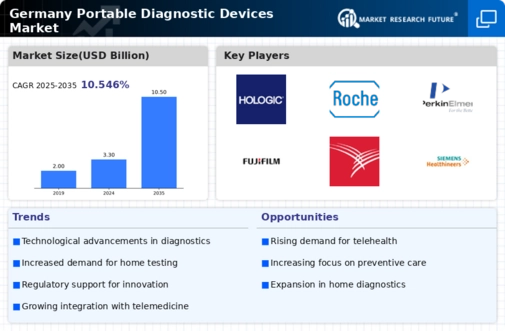Consumer Awareness and Health Literacy
Consumer awareness and health literacy are increasingly influencing the portable diagnostic-devices market in Germany. As individuals become more informed about health issues and the importance of early diagnosis, the demand for portable diagnostic devices is expected to rise. Educational campaigns and initiatives aimed at improving health literacy are empowering consumers to take charge of their health, leading to a greater acceptance of self-monitoring tools. In 2025, it is anticipated that around 60% of the population will actively seek out health information, which could drive the adoption of portable diagnostic devices. This shift in consumer behavior is likely to create new opportunities for manufacturers to develop user-friendly and effective diagnostic solutions, ultimately contributing to the growth of the portable diagnostic-devices market.
Integration of Digital Health Technologies
The integration of digital health technologies is transforming the portable diagnostic-devices market in Germany. With the rise of telemedicine and mobile health applications, there is a growing emphasis on devices that can seamlessly connect to digital platforms. This integration allows for real-time data sharing between patients and healthcare providers, improving the overall quality of care. In 2025, it is estimated that the digital health market in Germany will reach approximately €10 billion, indicating a robust growth trajectory. The ability to monitor health metrics remotely not only empowers patients but also enhances the efficiency of healthcare delivery. Consequently, the demand for portable diagnostic devices that can interface with digital health systems is expected to increase, driving innovation and investment in this sector.
Rising Demand for Home Healthcare Solutions
The portable diagnostic-devices market in Germany is experiencing a notable surge in demand for home healthcare solutions. This trend is driven by an increasing aging population, which necessitates more accessible healthcare options. According to recent statistics, approximately 22% of the German population is aged 65 and older, leading to a greater need for devices that facilitate remote monitoring and diagnostics. The convenience of using portable devices at home allows patients to manage their health more effectively, reducing the burden on healthcare facilities. Furthermore, advancements in technology have made these devices more user-friendly and reliable, enhancing their appeal. As a result, the portable diagnostic-devices market is likely to expand significantly, catering to the needs of a demographic that prefers receiving care in the comfort of their homes.
Increased Focus on Chronic Disease Management
Chronic diseases are a significant health concern in Germany, with conditions such as diabetes and cardiovascular diseases affecting millions. The portable diagnostic-devices market is responding to this challenge by offering innovative solutions for chronic disease management. Devices that enable continuous monitoring of vital signs and health parameters are becoming essential tools for both patients and healthcare providers. For instance, the prevalence of diabetes in Germany is projected to rise to 7.5 million cases by 2030, underscoring the need for effective monitoring solutions. The ability to track health data in real-time allows for timely interventions and personalized treatment plans, which can lead to better health outcomes. As a result, the portable diagnostic-devices market is likely to see sustained growth as it aligns with the increasing demand for chronic disease management solutions.
Government Initiatives Supporting Health Innovation
Government initiatives in Germany are playing a crucial role in fostering innovation within the portable diagnostic-devices market. Policies aimed at promoting research and development in healthcare technology are encouraging companies to invest in new diagnostic solutions. The German government has allocated substantial funding to support health tech startups, which is expected to enhance the competitive landscape of the market. Additionally, regulatory frameworks are being adapted to facilitate the approval of innovative devices, thereby accelerating their entry into the market. This supportive environment is likely to stimulate advancements in portable diagnostic technologies, making them more accessible to healthcare providers and patients alike. As a result, the portable diagnostic-devices market is poised for growth, driven by a combination of public and private sector efforts.


















Leave a Comment